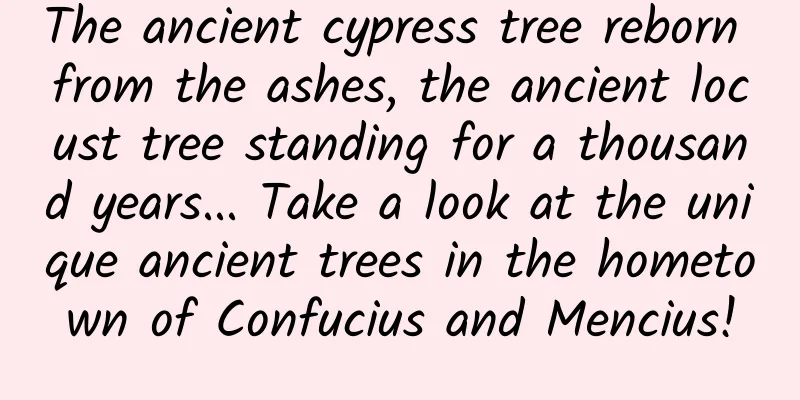The ancient cypress tree reborn from the ashes, the ancient locust tree standing for a thousand years... Take a look at the unique ancient trees in the hometown of Confucius and Mencius!

|
Produced by: Science Popularization China Author: Qin Yalong (Institute of Botany, Chinese Academy of Sciences, Jiangsu Province, Nanjing Zhongshan Botanical Garden) Producer: China Science Expo There are so many mysteries waiting for us to explore and discover on the planet we live on. In the five thousand years of Chinese civilization, there are countless magical plants in the long river of history, such as the dancing grass Codoriocalyx motorius (Houttuyn) H. Ohashi, or the well-known wild grass Artemisia argyi Lévl. et Van., or the world's most poisonous plant Antiaris toxicaria Lesch.... These magical plants contain infinite plant science knowledge. How to explain these magical plant phenomena and functions from a scientific perspective is the key to our understanding of the value of plants. Figure 1: Dancing Grass (Image source: provided by the author) Figure 2: Ai (Image source: provided by the author) Figure 3: Bloody throat (Image source: provided by the author) Today, we came to the birthplace of Confucianism, the hometown of Confucius and Mencius, to see the magical plants here. Jining, Shandong enjoys the reputation of "the hometown of Confucius and Mencius, the birthplace of culture". The Confucius Temple, Confucius Mansion and Confucius Forest of Qufu, the "Three Confucius" and the Meng Temple, Meng Mansion and Meng Forest of Zoucheng are all rich in history and culture, and retain a large number of cultural relics. There are also a large number of ancient trees and famous trees here to witness history, attracting more and more tourists to comprehend the profoundness of Chinese culture and witness the magic of plants. Figure 4: Sophora japonica (Image source: provided by the author) The old cypress embraces the locust tree, and new trees grow in its branches Outside the Zhiyan Gate of the Meng Temple, there are cypress trees planted along the wall. Dozens of ancient cypress trees are lined up in a row, lush and green, quite spectacular. Among these cypress trees, there is a tree with a thick and hollow trunk and a fork at the top of the trunk. Perhaps it was the wind that brought a locust tree seed into the heart of the ancient cypress (the tree hole). Since then, the ancient cypress has sheltered the locust tree from wind and rain and provided nutrients and water. Finally, after decades of care, the locust tree has soared into the sky, embracing the ancient cypress, like a couple leaning on each other. However, the cypress and locust trees in the Meng Temple are not unique. There are also magical phenomena of cypress and locust trees in Qianlong Temple in Weinan and Yao Temple in Linfen. The mysteries of nature are endless, and there are still many magical phenomena waiting for us to explore. Figure 5: Wolfberry (Image source: provided by the author) Chinese wolfberry grows on cypress trees On the terrace in front of the sleeping hall of the Meng Temple, there is a nearly thousand-year-old cypress. What is peculiar is that a clump of Lycium chinense Miller grows in a bird hole about two meters above the ground on its trunk. Every year when the wolfberries are ripe, the green leaves and red fruits of the wolfberries sway in the wind on the thick trunk of the cypress, attracting a large number of tourists to stop and watch. According to the "Three Migrations Records", this cypress was planted during the Xuanhe period of the Northern Song Dynasty. It is still green and lush. The branches on the top of the tree are shaped like a "deer turning back", which is also a sight. As for why wolfberries grow on the trunk of cypress trees, it all started with the bird holes on the tree. For some unknown reason, there is a hole on the cypress tree, where birds come to build nests and live. Or, in the season when wolfberries are ripe, the birds living in the tree holes eat wolfberries, and the undigested seeds are excreted in the bird holes through feces. In addition, there are fallen leaves and dust accumulated in the tree holes all year round, which can meet the needs of wolfberries to take root and sprout. When the wolfberry seedlings poke their heads out of the tree holes, they can also obtain nutrients through their own photosynthesis and bloom and bear fruit normally. This is how the beautiful scene of towering trees and red fruits finally came about. In nature, it is common to see other plants growing in the trunks, branches and tree holes of large trees, especially in the southern tropical regions, where hundreds of flowers grow together on the tall trees, forming a landscape of sky gardens. Figure 6: Ploughwort blooming in the hole of the magnolia tree (Image source: provided by the author) Figure 7: Staghorn fern growing on a tree (Image source: provided by the author) Figure 8: Dendrobium and Staghorn fern growing on trees (Image source: provided by the author) Born in mid-air, it has survived thousands of years of wind and rain. For more than 2,000 years, the stories of Mencius' mother educating her son, "Mencius' mother moved three times" and "breaking the loom to save her son", have been well known to women and children. Liu Xiang of the Han Dynasty praised her in "Ode to Mencius' Mother": "Mencius' mother educated her son in a unique way. She chose righteousness for her son and made him follow the great ethics. When her son failed to make progress in his studies, she broke the loom to teach him. As a result, her son became virtuous and became the best in the world." There are many cypress trees planted beside the South Hall of Mengmu Forest, where Mengmu is worshipped. The roots of these ancient cypress trees are exposed above the ground, intertwined and hanging in the air, hence the name "hanging trees". Although the roots of the ancient cypress trees are hollowed out, the trunks are still tall and vigorous, which is very unique. How is this wonder achieved? As a taproot plant, juniper has a strong taproot that grows underground. The ancient cypress has been eroded by wind and rain for many years, exposing its surface roots. Although the taproot and multiple lateral roots are exposed, they can still ensure that the cypress tree stands tall and luxuriant. Figure 9: The cypress planted by our teacher (Photo source: Veer Gallery) The old cypress is reborn, the thousand-year-old cypress is reborn from the ashes On the east side of the Dacheng Gate of the Confucius Temple, there is a relatively thin cypress tree. Next to it is a stone tablet with the words "The Master Planted the Cypress" engraved on it. It is said that this cypress tree was planted by Confucius himself. Originally, there were three of them, but they were destroyed by war. In 1294, a new cypress seedling grew on the ruins and was later moved here. In 1499, it was burned again and only the trunk remained. In 1724, the trunk was burned again and only the stump remained. In the tenth year of the Yongzheng reign of the Qing Dynasty, that is, in 1732, new branches sprouted from the stump. It has been nearly 300 years since then. Zhang Dai, a prose writer of the Ming and Qing dynasties, recorded in the book "Dreams of Taoan" that the cypress in the Confucius Temple was planted by Confucius himself. By the time it was burned for the first time, the cypress had grown for hundreds of years. Although the above-ground part had died, its underground root system was very large, and it had produced a large number of new secondary roots. This is why the thousand-year-old cypress can still sprout new buds and be reborn after the fire. Figure 10: Male flowers of Ginkgo biloba (Image source: provided by the author) Figure 11: Ginkgo biloba female flowers (Image source: provided by the author) Figure 12: Ginkgo fruit (Image source: provided by the author) Why is the vine-like ginkgo called the maidenhair tree? Ginkgo biloba L., a tree of the genus Ginkgo in the Ginkgoaceae family, can reach a height of 40 meters. It is a rare relict of the Mesozoic era that is unique to my country and is known as a "living fossil". Ginkgo has a beautiful shape, is green in spring, and turns yellow in autumn. It is an excellent garden and street tree. Its fruits and leaves also have high medicinal and edible value. Because the ginkgo tree has a very long lifespan, it takes more than 40 years from sowing to bearing a large number of fruits under natural conditions. Therefore, ginkgo is also called "grandfather-in-law tree", which means "father-in-law plants trees and grandsons get fruits". Figure 13: Wisteria (Image source: provided by the author) There are two towering ancient ginkgo trees on the east and west sides of the Zhiyan Hall in the Meng Temple. At the base of the right ginkgo tree, a century-old wisteria is entwined, which is called "vine-tied ginkgo". When we approach these two trees, you will find that only one ginkgo tree is full of fruits, while the other one is barren, because ginkgo trees are divided into male and female. Plants in nature are divided into monoecious and dioecious. Monoecious means that the flowers of a plant have both pistils and stamens, and dioecious means that female flowers and male flowers grow on different plants respectively. Ginkgo is a dioecious plant. The male cones of male ginkgo plants are catkins, which are responsible for pollination but not fruiting; the female cones of female ginkgo plants have long stalks, and the top of the stalks are often forked, growing into two ginkgo fruits in autumn. Sometimes one of the ginkgo fruits will abort, leaving all the nutrients to the other fruit. Looking at the moon from a locust tree in the cave, how did the ancient locust tree stand for thousands of years? On the west wall of the Burning Silk Pond in the Meng Temple, there is a thousand-year-old locust tree. Due to the wear and tear of time, the lower part of the tree has split, forming a hollow round hole in the upper part of its trunk. Whenever the moon rises, the bright moonlight shines through the hole in the tree and is reflected on the earth, which is quite quaint and interesting. At this moment, people can also stand under the tree and look at the bright moon in the sky through the hole in the tree, which is called "looking at the moon from the locust tree hole." The ancient locust tree in Donghuai Wangyue is a tree of the genus Sophora japonicum in the Fabaceae family. Its scientific name is Sophora japonicum (L.) Schott, which is also called Chinese Sophora japonicum in contrast to Robinia pseudoacacia. The locust tree was planted in the Tang Dynasty. During its long growth process, it was affected by lightning, strong winds, heavy snow and other factors, causing the locust tree to fall over and split, thus forming a tree hole. However, during the growth of plants, water and inorganic salts are mainly transported by the xylem of the stem, while the phloem transports organic matter. Although large holes have appeared in the ancient locust tree, the conduction between its xylem and phloem has not been interrupted, and the phloem provides strong support. Coupled with the protection of people from generation to generation, the ancient locust tree can stand for thousands of years without falling. Figure 14: Solanum jujube (Image source: provided by the author) Why do wild jujubes grow into big trees? There is a tall jujube tree on the north side of the back five rooms of the Confucius Mansion. It is said that the jujube tree was planted 500 years ago when the wives of the Duke of Confucius loved to eat jujubes. In order to facilitate picking and eating, they transplanted the jujube tree behind the Confucius Mansion's back hall. Today, only this jujube tree remains, and it may have grown into a big tree due to the careful care of generations. Ziziphus jujuba var. spinosa (Bunge) Hu ex HFChow., a plant of the genus Ziziphus in the family Rhamnaceae, is commonly seen as a shrub. Since ancient times, Ziziphus jujuba has been distributed in many provinces of my country, growing in mountainous areas, hills or plains below 1,700 meters above sea level. Whether it can grow into a big tree is closely related to its growing environment. The common Ziziphus jujuba trees in the wild are mostly shrubs, and rarely grow into trees, either because of the harsh growing environment, or because of artificial felling or different varieties. Figure 15: Zigong’s hand-written calligraphy (Photo source: Veer Gallery) Zigong's calligraphy tree has stood for a hundred years without decaying. Among the numerous ancient and famous trees in the Confucius Forest, there is a special Chinese calligraphy tree. The only remaining stump is protected by a pavilion, and a monument is erected in front of the pavilion, inscribed with "Zigong planted Chinese calligraphy with his own hands". It is recorded that "after Confucius passed away, his disciples moved rare trees from all directions to plant, and Zigong transplanted this Chinese calligraphy sapling from another place to the side of his teacher's tomb. Confucius' disciples guarded the tomb for three years, but only Zigong guarded the tomb for six years." It was hit by a thunderstorm during the reign of Emperor Kangxi of the Qing Dynasty, and only the trunk remained. Figure 16: Pistacia chinensis (Pectinaceae) (Image source: provided by the author) The Kai tree is actually a deciduous tree of the Anacardiaceae family, Pistacia chinensis Bunge. Its trunk is sparse but unyielding, and it is upright and straight. It has been a symbol of respecting teachers and valuing education since ancient times. Pistacia chinensis Bunge can reach a height of more than 20 meters, grows slowly, and can live for hundreds of years. Therefore, its wood is hard and dense, not easy to crack, and is relatively corrosion-resistant. The "Zigong hand-planted Kai tree" in the Confucius Forest may have formed a layer of carbonization on its surface due to the lightning and fire, making it more resistant to corrosion. Later generations built a square pavilion with gray tiles and a pointed roof on the dry tree stump, named "Kai Pavilion", and erected a "Kai Tu Monument" in the pavilion. With the protection of the pavilion, the tree stump is protected from wind and frost, thus further ensuring that the Kai tree will not rot for a hundred years. On one side of the Kai Pavilion, there is a stele with a poem written by Shi Runzhang, a poet in the early Qing Dynasty: "It is hard to tell when it was planted, but the broken stele remains today. Looking at the shadow of the single tree together, we can still see the hearts of the ancients. After experiencing all the wind and frost, the vast sky and earth are gloomy. Passing by the place where the house was built, it is only touched once in a thousand years." Conclusion The magical plants in the hometown of Confucius and Mencius have gone through wind and rain and have been passed down to this day along with Confucian culture. I believe that through this article, I can not only provide you with a reference for local tourist check-in points, but also allow you to truly understand these plants and understand the culture and knowledge behind them. Editor: Sun Chenyu (Note: Latin text should be italicized.) |
>>: As spring arrives and flowers bloom, beware of animal injuries that may cause anaphylactic shock
Recommend
Plants also have "social phobias" and become "shy" when touched lightly →
If you touch it lightly, its leaves will close im...
Tips for scientific placement of information flow ads!
With the vigorous development of mobile communica...
Improvement of official document writing: Make your official documents sophisticated and friendly
Long Yu, a condensed version of 10 years of exper...
Do you know all the new features of iOS 10?
[[172403]] What did Apple release at the just-con...
It is difficult and expensive to take a taxi in 2017. Is this really the original sin of the product and its operation?
During the 2017 Spring Festival travel rush, why ...
Can eating konjac help you lose weight? Pay attention to these two points!
01 Why is konjac so low in calories? Konjac has a...
600℃ high temperature resistant memory is launched! How can AI fight back in danger?
The discovery of ferroelectric aluminum scandium ...
Tesla still stubbornly insists on the visual route. Will LiDAR have the last laugh?
Recently, Musk showed off his strength at Tesla&#...
Debug your code like a doctor
Designing and maintaining good software is a neve...
How to write an information flow advertising creative with a CTR of 8%?
To be honest, as a veteran in the marketing indus...
An ancestral precept has governed the country for 600 years. This "pearl" in the vast forest of northern Fujian is creating an ecological miracle.
Wanmulin Nature Reserve in Jianou City, Fujian Pr...
How many steps are needed to keep a spacecraft “neither hot nor cold” in the universe?
When we imagine space You might think of the vast...
Analysis of Git's 4-stage undo change command
Although git has been around for 12 years and the...
How dangerous are the beautiful balloons sold on the street? An experiment will tell you!
During the Spring Festival, you can always see so...









